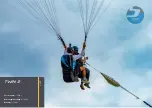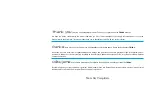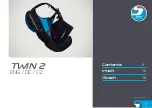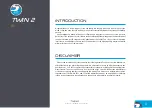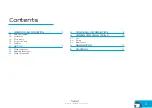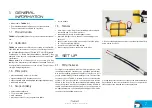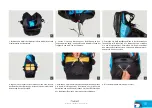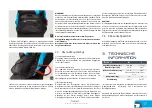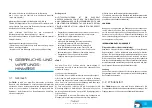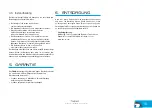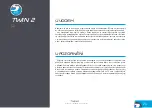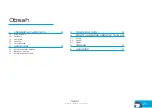
User manual / Handbuch / Návod k obsluze
TWIN 2
9. Fix the flaps with the pins to their corresponding length.
Short pin to the closer eyelet. Longer pin to the distant eyelet.
Secure short pin with the rubber O-ring.
9
10. Route the handle tape below the security flap and then
insert the handle into the pocket and
secure with the Velcro strap.
10
WARNING!
After installation of a reserve parachute in the harness, it is absolutely
essential to do a simulated deployment under a static swing,
ensuring that the parachute release system operates correctly and
the parachute comes out easily. The loops which close the reserve
pocket must be checked regularly. If the cord is worn, it must be
replaced. Each time a reserve parachute is installed, check that the
cord is in good order by applying a load of 10 kg. Before each flight,
check that the pins and handle are located correctly.
The correct throwing technique has to be used – a pull to the
side.
We strongly recommend practising the correct throwing
technique on the simulator.
Please note, that the parachute can only be deployed with the
right hand.
2.2. Adjusting the harness
1) Side Adjustment
An excessively reclined position reduces stability and increases
the risk of risers twisting in the event of a spin.
2) Shoulder Strap
Adjustment For optimum comfort during take-off and ease of
achieving your preferred flying position the shoulder straps
should not be excessively tight. The straps may appear loose
while in the seated position but some play is required to avoid
excessive strap pressure in the standing position.
3) Main Chest Strap
Adjustment Tightening the chest strap increases the efficiency
of the Auto Balance System (ABS, i.e. stabilising system)
but decreases the roll response of the wing. With increased
tightening, the pilot may feel more stable in turbulent conditions
and the wing will be more stable in the event of an asymmetric
collapse. However, the wing may be less inclined to bank when
turning. The design of the integrated ABS allows for good
stabilization throughout the adjustment range.
WARNING!
The chest strap adjustment can be quite sensitive and it is best to test
first under a static swing, and only then in still air flight, before trying
to adjust it during a turbulent flight. Before taking off, do not forget to
pre-adjust your chest strap. This will result in a more comfortable flight.
2.3. Fitting the speed kit
With regard to the use of the TWIN 2 harness the harness is not
ready and cannot be used with the speed system.
3. TECHNICAL
INFORMATION
* Weight including harness, integrated foam back protector,
main carabiners, rescue handle, rescue parachute bridle
protection sleeves.
Because of the separate leg segments, the height of suspension
points and chest strap range points varies with the pilot.
Min. and max. volume of the rescue parachute container:
min. 5.3 liters – max. 9.3 liters
(for example min. Sky Quatro
Light 160 – max. Sky Spare Bi)
Maximum clip-in weight (weight in flight): 120 kg
TWIN 2
M
L
Pilot´s height (cm)
160-180
175-195
Suspension points height (cm)
44-45
46-47
Chest strap range (cm)
44-45
46-47
Protector
Foam protector (15 cm)
Harness weight (kg)*
2.8
2.9
Certification
EN/LTF
EN/LTF
9
Summary of Contents for TWIN 2
Page 1: ...User manual for TWIN 2 Bedienungsanleitung für TWIN 2 Manuál pro TWIN 2 2022 TWIN 2 ...
Page 3: ...Contents 5 Inhalt 12 Obsah 19 Version 1 0 19 07 2022 3 TWIN 2 ENG DE CZ ...
Page 6: ...User manual Handbuch Návod k obsluze TWIN 2 6 ...
Page 14: ...User manual Handbuch Návod k obsluze TWIN 2 14 ...
Page 22: ...User manual Handbuch Návod k obsluze TWIN 2 22 ...

